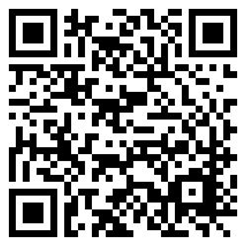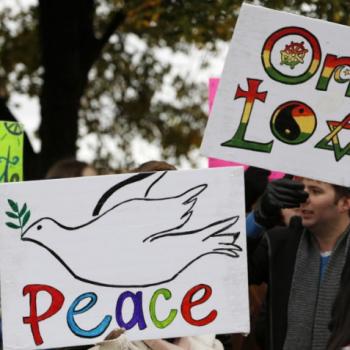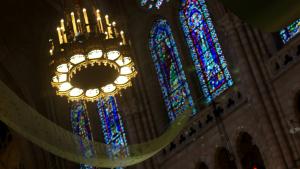We’ve been listening for the past few weeks to passages from the Gospel of Matthew about Jesus tangling with the leaders of the Jewish community in Jerusalem. Remember, in Matthew’s account of the way things went down the last week of Jesus’ life, Jesus was making his presence known all over town. Today’s passage, also from Matthew chapter 22, is the final public conflict Jesus had, the argument that tipped the scales and sent the leaders of Jerusalem to Plan B, their plan to get rid of Jesus once and for all.
To understand better what is happening here at the end of Matthew 22, we must remember that the Roman government occupied Jerusalem and surrounding regions. In order for Rome to exert control of the area, the Romans assigned a governor, who at the time happened to be a guy named Pontius Pilate. After hundreds of years of domination, it was not the Jewish tradition to submit quietly to an occupation like this, but that’s what had slowly happened. The Jewish high priest, Ciaphas, had established an alliance with Pilate; they worked together to insure each others’ interests.
And Jesus, the radical upstart who had gained such a following among the average Jew around town, was not amused. There was too much power concentrated in one place, and the end result of that trend was things like we talked about last week: crushing tax burdens; unfair legal systems; a whole class of people who struggled for day to day economic survival. In this system, while life was hard for so many, there were a few—including those in power—for whom life was just fine.
Great, really.
And any voice that challenged the system was a voice that needed to be quieted before anybody got too upset.
Jesus was one of those voices.
Jesus’ adventures of this week began on the occasion of his entry into Jerusalem. You remember that story, right? Everyone was cheering Jesus on, waving palm branches, and calling him Messiah—Savior. What you might not know is that that week when Jesus came into Jerusalem on the donkey was the very beginning of the celebration of Passover, one of the most holy weeks of the Jewish year. Because of that holiday, the city of Jerusalem was bursting at the seams; its normal population of about 40,000 people had swelled to over 200,000 for the celebration. To take advantage of the pilgrimage of people from all over the region, Pilate, the Roman governor had the custom of staging a military procession on the Western side of Jerusalem. It was like a celebratory parade, but it was staged and timed to be sure that everyone there felt the display of power. In full military dress, chariot and horses, a procession of military precision began and continued through the city. The message was clear: I am in charge, you are my subjects, I have the power.
You recall, then, that on the Eastern, mountainous side of the city at the same exact time, there was Jesus. He was also involved in a staged entrance to the city, but he wasn’t wearing armor. And he also was not riding in a chariot, accompanied by impressive war horses, military regalia, or formations marching in precision. It was just him, remember, on a donkey, making his way into the city and being cheered by a crowd—the crowd that chose specifically to attend this entry parade and not the other one, because they knew exactly what Jesus was up to. Pilate and his parade were showing the power of the Roman establishment, of royal palaces and oppressive laws, of people oppressed by powers they could not overcome. Jesus, on the other hand, was preaching a completely different message: that true power came from love of God and love of neighbor, that change can happen on a donkey to the sound of children singing, that there is no need for fancy trappings, only sincere hearts. Two entries into the city, happening simultaneously. Two completely different messages they sent to those who watched them. And a sharp conflict of ideologies happening in those very public demonstrations. With all the might of the Roman army and the joint power of the Jewish leaders, what possibly could have been so threatening about this one who talked constantly about a different way to live?
Two kingdoms were colliding, two very different views of how life should be lived. And now that Jesus was in the big city with a clear influence on many people who had begun listening to his message, well, that felt threatening to all of those who held the power monopoly.
You’ll remember that Jesus was everywhere: turning moneychangers’ tables over in the temple, telling radical stories about the Kingdom of God, and generally antagonizing the religious leaders, who over and over got embarrassed in front of the whole crowd as they tried to trick Jesus into saying something that would end his career as a celebrity once and for all.
The scripture we read this morning was the final public test. The Pharisees put their heads together again and decided they would test him with a question to end all questions: they decided to ask him to tell the crowd what the most important commandment is—the one everybody had to obey or else.
The religious leaders and also the people who were listening were very interested in rules and commandments; rules were the foundation of their faith practice. And so, everyone (even the ones who didn’t support the Jewish leadership) would want to know what Jesus had to say about this question.
And Jesus answered, though I am quite sure he was annoyed. “Love the Lord your God,” he said, and “Love your neighbor as yourself.”
This sounded very good, how could they argue with an answer like that? But the way Jesus meant it, it somehow stood in contrast to the list of laws the Jewish leaders required. It was simple and clear, challenging and applicable to everyone. And it was hard. So hard.
The problem was that everyone trying to meet the standards of the Jewish leadership around town was struggling with the challenge of loveless law. That is, there were rules, you know, and they had to be followed forever and always. Even if the following of the rules hurt other people.
In a society in which everyone depended on everyone else, a ruthless rule following, while seemingly admirable, ended up not healing communities and deepening individual lives, but instead becoming a weapon by which some people were good and others were not good enough. The adamant following of laws ended up creating a situation in which there was a loveless law—laws followed no matter what, just for the sake of following the laws.
Jesus wasn’t interested in an elaborate law if it wasn’t infused with love. Instead, love was his law: to love God and to love your neighbor.
I am quite sure that all the people in Jerusalemwho heard Jesus that day felt overwhelmed by what they’d heard. I know I do. It must have seemed easier, in some ways, to have a whole list of behavioral rules to follow to the letter. Love God? Love your neighbor? These are clear directions that are often way too hard to follow. Way too hard. Could Jesus have meant that we should try to do them? Could really loving God and practically loving our neighbors actually change things? Could following directions as simple and as radical as these really change the world?
So, here we are on stewardship Sunday. Today is the day that, as a community of faith, we come together to offer our lives in the efforts we make as a church to follow Jesus’ directions. Coming together to share what we have and who we are is not a rule that you have to follow or else you’ll get kicked out. It’s much bigger than that. It’s a challenge during which you are called to dedicate your life…to give all that you have and all that you are to this effort of being the church in this time and place…because you believe with all that you are that this community of faith is a our corporate expression of following Jesus’ directions to love God and love our neighbors.
Like Jesus, we want to be people who live the law of love, a community that is structured and defined by radical love. As Jesus told the Pharisees that day, every other rule or law hinges on the law of love. It’s a foundation we’re building together.
This week while I was perusing Facebook, I saw a picture posted by some of my friends that reminded me of the directions Jesus gave. It was the picture of a sign in the door of a Durham, NC, dry cleaner. The sign reads: “If you are unemployed and need an outfit cleaned for an interview, we will clean it for free.”
In an interview with the owner he expressed sympathy for all of those looking for work, as he had been at one point. Cleaning folks’ professional attire for free was an expression, he said, of “being a good neighbor.”
Indeed.
While I am not sure what the exact motivation of this business person was, I think this may, in fact, be a really good description of following directions. Jesus’ directions. There were not loveless laws…a list populated by so many things we have to do…or else. Rather, Jesus was more about lawless love…that is, that our lives are ruled by love, not law, and it’s the standard of love that demands our response, ever and always.
Today as a community of faith we have the opportunity to make a commitment and participate in a cause larger than ourselves. Together we are people who can live the radical witness of Jesus, who can be agents…not of a loveless law…but of a reality in which love is the main deciding factor of what we do and who we are.
Love God, love your neighbor. These are truly the directions Jesus left for us. The question for us this day is: will we follow the directions of Jesus? Will we give our lives in service and love to God, and in the love of our neighbor? These are hard things, standards to which most of the world does not subscribe. Will we try it? Will we commit to following Jesus’ directions or not?
As today is Stewardship Sunday, I get to finish my sermon today by giving you some directions. They are not as simple as Jesus’, but I do think these directions are easier than loving God and loving our neighbors. Who among us today has a smart phone? May I ask you to pull it out (and we can pretend you weren’t checking email, etc., during the sermon?)? Please pull it out and open the application that reads QR codes.
QR codes are those square codes (see one in your bulletin?) that apparently your smart phone can read. And when you read such a code with your smart phone, the code will take you directly to the Calvary stewardship page.
To give you and me a chance to follow directions, I am going to give you a minute to scan that QR code and actually make a donation—it could be 5$–not all that much…but you will have followed directions to scan the code and make that donation. Try it!
Aren’t we so technologically savvy?
If you don’t have a smart phone, or if you just think I am crazy, now would also be the time to open your stewardship brochure and fill out your pledge card. Let’s do either one of those or both together now….
Clear, concise, easy to understand: when Jesus answered the Pharisees he was telling everyone what the basics were. Follow directions, friends. Love God, and love your neighbor. That’s it. It’s love without the law, a radical way of living in the world. And Jesus the radical parade leader, was there to show them that there was another way to live. Love God, love your neighbor. Follow those directions and you’ve got it all covered. All of it.
As a symbol of how we are better together when we join each other in following Jesus’ directions, we will have the opportunity to come forward and place on the altar the pledge cards we’ve filled out. If you have already turned in your pledge card, no need to fill in another one, just bring your stewardship brochure up front to the altar. These are financial commitments as part of our membership in this community of faith, of course. But more than that, they are a symbol that we—together—are ready and willing to follow directions, to allow our lives to reflect this very high standard of loving God and loving our neighbor.
Do you think we can do it? Do you think we can follow directions?
In the moments that follow we will bring our pledge cards to the altar, our corporate acknowledgement that we are better together, and that together we are determined to follow this Jesus who gave us the most difficult and wonderful directions: love God and love your neighbor.
Let us truly and tangibly do that now.
Amen.












